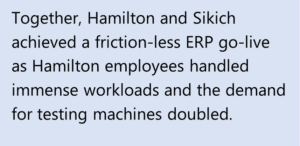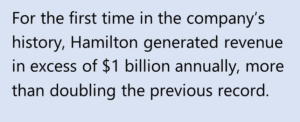This website uses cookies so that we can provide you with the best user experience possible. Cookie information is stored in your browser and performs functions such as recognising you when you return to our website and helping our team to understand which sections of the website you find most interesting and useful.
Impossible Conditions Can’t Stop a Customer-Driven Company Transforming on Modern Cloud ERP

Sikich offers a repeatable, rapid way of driving digital transformations and helping customers achieve dramatic, fast growth even under the constraints of a global emergency. Key to the success of this practice is deploying Microsoft Dynamics 365 solutions by following our HEADSTART methodology, which comprises best practice-infused processes and complete, fully functional models of CRM and ERP systems. The successful project Sikich delivered to Hamilton Company, an engineer-to-order manufacturer, showcases how we can help companies modernize on a cloud platform and realize the value of enterprise-level ERP quickly.
Delivering ERP during a pandemic-driven demand boom

The Hamilton Company provides automated liquid handling workstations, precision measurement devices, robotics, process sensors, pipettes, and other products to healthcare providers, laboratories, and life sciences companies around the globe. One of its customers is the U.S. Department of Health and Human Services (DHHS). In 2020, as the pandemic spread quickly, Hamilton saw a more than 10-fold increase in orders for its liquid handling robotic equipment. In March of 2020, Thermo Fisher Scientific ordered more than 2,000 automated Hamilton MagEx STAR and STARlet devices used to isolate pathogen RNA from COVID-19. In the same period, DHHS also ordered a large amount of ventilators.
The increased customer demand prompted by the pandemic emergency required Hamilton to re-engineer its business systems, vastly increase its production capacity, and augment its workforce—or it would not be able to deliver in a timely manner what customers needed. As Alex Ingram, IT Director at Hamilton, describes, company leadership found Microsoft Dynamics 365 promising because Microsoft keeps investing in innovating and evolving the technology. Sikich was an attractive deployment partner, offering an ERP recovery and turnaround service when an earlier effort with another consultancy had not been fruitful. For Hamilton, it was also critical to collaborate with consultants who understood the business.
Working with Sikich, Hamilton fast-tracked plans to modernize its technology environment with a modern, cloud-based, future-resilient ERP solution: Microsoft Dynamics 365 Finance and Supply Chain Management with Field Service, Project Operations, Customer Service, and Human Resources. Together, Hamilton and Sikich achieved a friction-less go-live as Hamilton employees handled immense workloads and the demand for testing machines doubled. Sikich facilitated the collaboration and ran the entire project through Microsoft Teams.
Realizing ERP value without the wait

We put the Sikich HEADSTART model to work to accelerate and simplify the ERP delivery, opening a path for Hamilton to modernize its operations on a standardized solution with an extremely short time-to-value. Sikich only took six weeks to deliver a first conference room pilot for the client’s hands-on experience. That pilot provided much more than an early-stage visualization of what Hamilton could expect: some stakeholders felt that the organization could have gone live and accomplished significant improvements even with this first pilot.
Built around Microsoft Lifecycle Services, HEADSTART comprises complete, production-ready models of the Dynamics 365 solutions that typically meet 80 percent or more of clients’ requirements. Its business process library includes hundreds of standardized, best practice-driven processes to support ETO operations.
HEADSTART also comes with many preconfigured Microsoft ISV solutions to meet specific customer requirements. In Hamilton’s case, process automation software from 9altitudes (formerly Ad Ultima) became part of the ERP environment.
Transformational outcomes all the way to the digital factory
As a result of the Dynamics 365 deployment, Hamilton achieved many new process efficiencies. Collectively, these greatly benefit the company’s productivity. Purchasing was one of the first lines of business to see dramatic improvements. The automatic generation of purchase orders reduced the time needed to set up a purchase order from up to two hours to a few minutes. With help from Sikich, whose consultants created dashboards and custom reports using Microsoft Power BI, increased visibility has become similarly pervasive. Executives and teams involved with demand planning, inventory management, field service, HR, and other areas of the business benefit from enhanced insight and control.
On Hamilton’s powerful, extensible cloud ERP platform, the company is charting its journey all the way to the connected, digital factory of the future. It has already defined several objectives for the second wave of ERP modernization. This undertaking will include extending the Dynamics 365 environment with asset management, shopfloor integration, more robust nonconformance management, machine integration, and a Sikich mobile app for warehouse automation.
Other remarkable outcomes of the ERP project include:
 Double capacity and record revenue. Hamilton doubled its production and workforce in time to meet urgent customer demand. Cloud technology enabled many employees to work anywhere and keep up the company’s increasing pace during the pandemic. For the first time in the company’s history, Hamilton generated revenue in excess of $1 billion annually, more than doubling the previous record.
Double capacity and record revenue. Hamilton doubled its production and workforce in time to meet urgent customer demand. Cloud technology enabled many employees to work anywhere and keep up the company’s increasing pace during the pandemic. For the first time in the company’s history, Hamilton generated revenue in excess of $1 billion annually, more than doubling the previous record.- Dependable demand planning. The company now can accurately forecast demand and address capacity constraints early on by reassigning production among locations, adding manufacturing machinery, or renegotiating delivery schedules. This allows Hamilton to ensure the best possible customer experiences and confidently accept and fulfill unprecedentedly large orders.
- Demand-aligned inventory. Inventory replenishment and ordering match forecasted demand. With incomplete visibility of inventory and supplier delivery times in the past, Hamilton procurement often purchased excess inventory to avoid outages. Today, that is no longer necessary, freeing up several millions of dollars for other investments.
- Customer-centric project management. Today, Hamilton produces every device as a project, managed in Dynamics 365 Project Operations. Business managers rely on Project Operations to asses the financial performance of Hamilton products and the profitability of individual customers. With end-to-end lifecycle visibility of the performance of its products at customer sites, Hamilton can meet contractual commitments and deliver timely warranty services even with a greatly increased business volume.
- Greater impact of the service business. Field service and the revenue it generates will become increasingly critical for Hamilton as it reengineers its machine products to have longer lifespans. Hamilton manages service operations and dispatches technicians through Dynamics 365 Field Service (CE), which automatically proposes service visits according to contracts and warranty details recorded in the ERP system. Service-related costs roll up into Dynamics 365 Finance for accurate reporting and prompt invoicing.
- Evolving the workforce. The company manages its growing workforce with Dynamics 365 Human Resources. With greater agility and efficiency, HR can deliver high-quality employee experiences that reflect Hamilton’s business culture. During an industrywide shortage of talent, Dynamics 365 as deployed through HEADSTART incorporates a wealth of industry expertise that can help Hamilton employees advance and mature their skills. By the same token, the company can minimize the disruption of turnover in the workforce.
Here to help
Is it time to modernize your ERP environment or the data center infrastructure? You could take these next steps:
- Contact Sikich.
- Read our in-depth web story about the collaboration with Hamilton Company.
- Take a closer look at how we help clients benefit from cloud ERP solutions.
- Follow us on Twitter, LinkedIn, Facebook, and YouTube.
This publication contains general information only and Sikich is not, by means of this publication, rendering accounting, business, financial, investment, legal, tax, or any other professional advice or services. This publication is not a substitute for such professional advice or services, nor should you use it as a basis for any decision, action or omission that may affect you or your business. Before making any decision, taking any action or omitting an action that may affect you or your business, you should consult a qualified professional advisor. In addition, this publication may contain certain content generated by an artificial intelligence (AI) language model. You acknowledge that Sikich shall not be responsible for any loss sustained by you or any person who relies on this publication.




